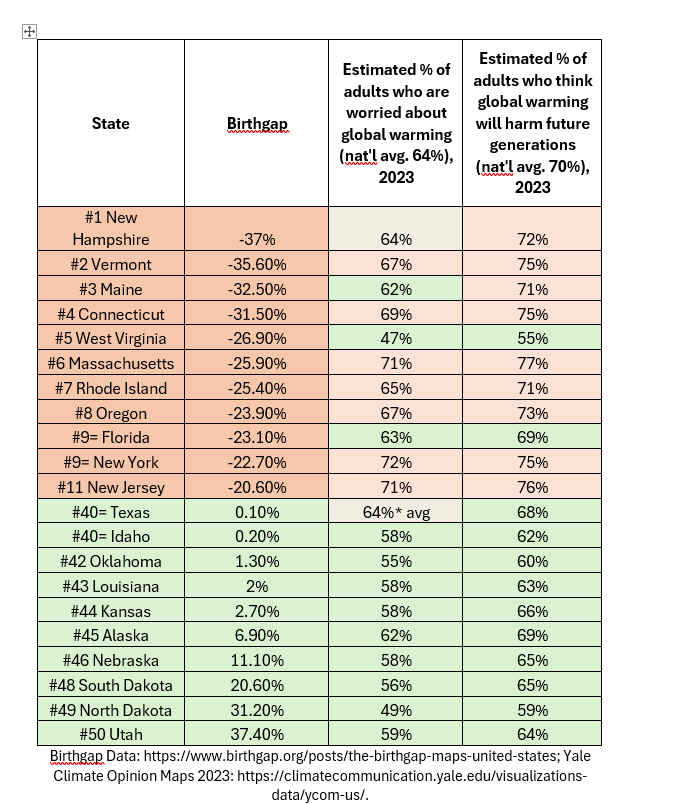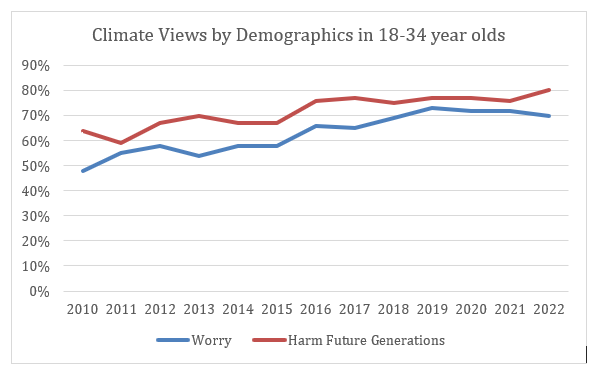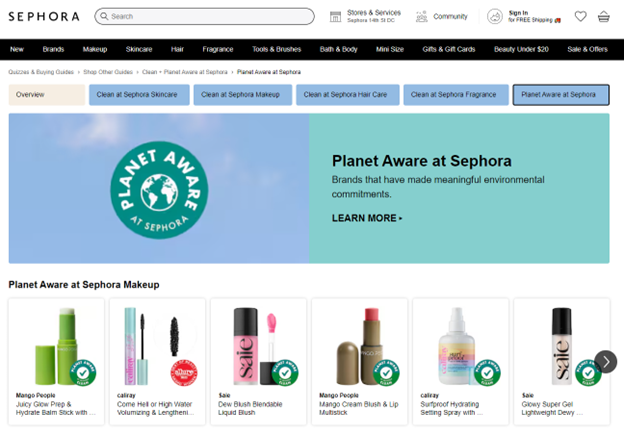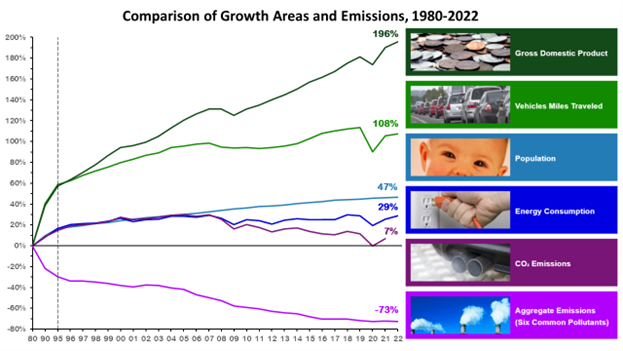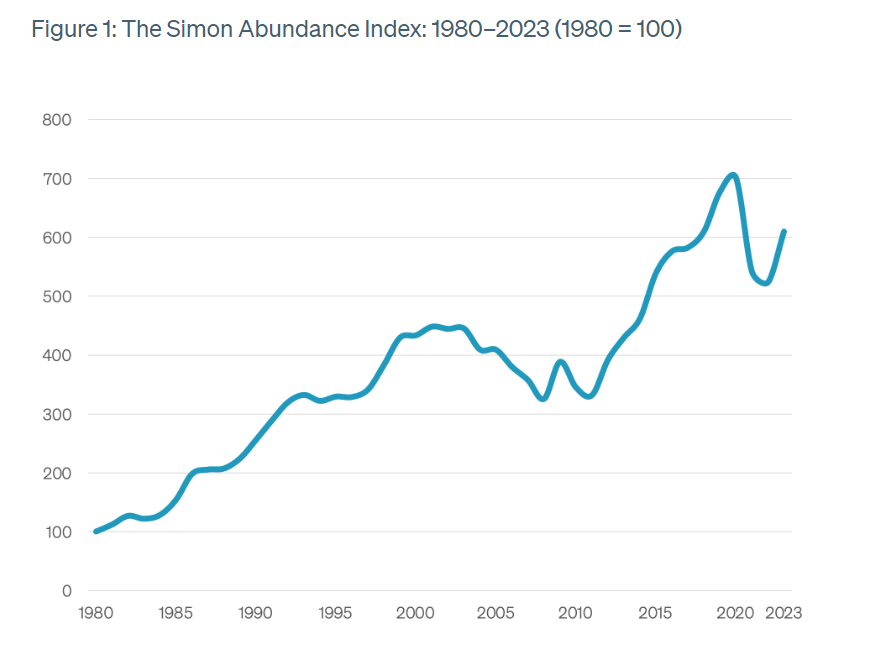Combatting Climate Anxiety: Yes, It Is Okay To Have Children
In today's climate-conscious world, discussions about personal choices, such as grocery shopping and plane travel, and their environmental impact have reached a fever pitch. This has produced a novel type of environmental anxiety, particularly affecting young people.
Considering our growing replacement rate problem, meaning people are not having babies at a high enough rate to sustain normal economic growth, it’s time to examine more closely what problems are particularly plaguing my generation of Americans (Gen Z) and take steps to clarify that the earth can handle a growing, global population and quality of life will continue to improve.
It is no surprise that climate anxiety, sometimes called “eco-anxiety” has become increasingly pervasive, considering the focus our education institutions place on metrics like one’s carbon footprint. I recall in college, in one of those required freshman year seminar courses, being asked to calculate our personal carbon footprint, and then also to compare our American carbon footprint with people from other countries. This and similar exercises aimed to elevate our environmental consciousness. It was educational, we visited our local landfill, learned about worm farming, and discussed the different sociological benefits of being in nature. If I recall correctly, in an essay for the class, I vowed to no longer eat pork and to generally reduce my meat consumption out of concern for the planet (this did not stick).
This focus on personal contribution to climate change wasn’t unique to my small liberal arts college, rather it’s the standard for postsecondary institutions in the West. My younger brother and his friends, who attended a large public university, all had a similar experience, as did my high school friends who attended a wide variety of schools. The default sermon we all heard in classrooms was this: Every person, by living their normal lives, is harming the planet in some way and out to mitigate that harm.
This message, evangelized both by professors and other gung-ho Malthusians in the media, has led some to question the ethical implications of bringing children into a world perceived to be threatened by environmental degradation.
Following that doomerism logic, why should you bring another person into our dying world? Why increase your family’s carbon footprint? Why bring another carbon emitter into existence? Things are going to hell anyway!
If children are taught in school and then later in college, just as I was, that every additional person is a resource burden on the planet, then climate change can easily become a convenient, morally righteous, excuse to delay or forgo having children all together.
The result being that having children becomes an opt-in rather than an opt-out decision for couples—something that you need a specific reason to-do rather than not to do.
If we move towards the default that not having children rather than having children, then the Birthgap, meaning the disparity between aging adults and babies, will only continue to grow.
In the United States, as of 2020 we had a 14% Birthgap, with 4.2 million people aged 50 compared to only 3.6million newborns. This age comparison was chosen by researchers because in 20 years’ time, newborns will typically be entering the workforce, will 50 year olds will expect to be retiring, give or take a year or two. If there is a significant difference between the numbers in these two age groups it is will be problematic in the years ahead, economically and socially. This gap has been widening significantly in recent years, particularly in the Northeast. New Hampshire (37%), Vermont (36%) and Maine (33%) have the largest Birthgaps.
When comparing state birth gaps to data from Yale’s latest Climate Opinion Map survey, it’s notable that the only 10 states in the U.S. that didn’t have a birth gap in 2020 were also the only 10 states in 2023 that reported that they were both less worried about global warming that the national average (Texas was the only state with a surplus to report the average amount of worry) and also reported lower than the national average of support for the statement “global warming will harm future generations.”
Yale’s survey data also showed growing worry and support for the statement “global warming will harm future generations” since 2010 amongst young people surveyed.
These statistics don’t paint a complete picture of how climate worry or global warming distress is affecting how American’s factor in those concerns to having children, but it does clearly show that there is a correlation between states with higher optimism about the future, birth rates, and lower worry about global warming.
It’s also clear that Americans are growing more distressed about the climate, as we can see with increasing rates of American’s risk perceptions since 2008.
Looking to a survey specifically on climate anxiety, commissioned on behalf of the American Psychological Association, more than two-thirds of adults (68%) saying that they have at least a little “eco-anxiety,” defined as any anxiety or worry about climate change and its effects. And about half of 18-34 yr olds, meaning Millennials and Gen Z, say the stress they feel about climate change affects their daily lives.
This survey data also tracks reports from therapists. “I think a lot of therapists do recognize that these issues have clinical relevance,” said Susan Clayton, a climate anxiety research psychologist to the Scientific American in an interview about the topic. The American Psychiatric Association (APA) also recently recognized climate change as a growing threat to mental health.
The reason for this explosion in concern could be the explosion of NGOs, meaning nonprofit organizations that operate independently of the government, evangelizing the same message of humans = harm, just like my professor in college did.
According to Cause IQ, a consulting firm that specializes in non-profit data, there are presently 30,593 environmental organizations in the United States. Combined, these environmental organizations employ 137,690 people, earn more than $28 billion in revenue each year, and have assets of $74 billion. There has also been considerable effort, and money spent, to focus media attention on climate change reporting. Organizations like Covering Climate Now, the Fund for Environmental Journalism and a host of other programs and fellowships specifically funding “environmental” or “climate journalists,” at both national, regional, and local newspapers has certainly drawn attention to the policy agenda of the authors and their backing organizations.
We can see how this climate consciousness has bled into the aisles of drugstores as well as television marketing campaigns. Skincare and makeup products market themselves as “environmentally sustainable” and “carbon neutral,” or use the impossibly vague term “clean.”
Every plane ticket purchase is now accompanied with a donation option to offset the carbon emissions from one’s flight.
It seems an ever-growing number of our daily purchases and activities are sold to us with an accompanying note about their environmental morality, perhaps to alleviate the consumerist guilt felt by a growing number of eco-anxious shoppers.
One recent study published by the journal Environmental Research Letters gives a good example of the philosophy of the population doomers. The paper focuses on the average carbon footprint of each particular person and suggests that, “opting to have one fewer child in a wealthy country could potentially reduce a family's carbon footprint by 58.6 tonnes per year over an 80-year lifespan.”
Fortunately, we all do not worship at the altar of carbon reduction-- or at least we don’t yet.
Children bring joy and allow for a unique investment in the future. Importantly, some children grow up to be great thinkers and innovators, improving the world they live in. What if Nikola Tesla's parents decided that having children was a sin against the Earth? What if Einstein’s parents decided the same?
It’s essential to combat any fearful concerns about population growth and family formation caused by climate anxiety with the clear, fact-supported message that each year, our abundance of resources and wealth grows, while the continuous stream of technological innovations propels us toward an ever-improving quality of life.
It's essential to approach the issue with optimism and a belief in humanity's capacity for innovation and adaptation. Advocating for a future that embraces both environmental stewardship and human flourishing requires striking a delicate balance. Rather than viewing population growth as inherently detrimental, let us embrace a vision of sustainability that values human life while safeguarding the planet for generations to come.
It’s unfortunate that climate anxiety is on the rise, especially because things are going quite well in terms of energy innovation, resource abundance and global health, particularly for air quality. Despite population and industry growth in the United States between 1980 and today, we’ve decreased air pollution.
Chart source, EPA: https://www.epa.gov/air-trends/air-quality-national-summar
Another helpful metric we can look at in order to understand the improvement in resource quality is The Simon Abundance Index. The Index quantifies and measures the relationship between resources and population, converts the relative abundance of 50 basic commodities and the global population into a single value. This allows us to understand, generally, if things are better now than they were before.
For some history, The Simon Abundance Index, named in honor of economist Julian Simon from the University of Maryland, stems from his observation that as the global population expanded, resource prices tended to decrease rather than rise, serving as a reliable indicator of abundance or scarcity.
Simon famously engaged in a wager with Stanford University Ehrlich, a proponent of the "overpopulation" catastrophe theory.
Paul Ehrlich, an American biologist, gained notoriety for his book "The Population Bomb," published in 1968, which warned of imminent global famine due to overpopulation. Despite its alarmist predictions, many of Ehrlich's forecasts failed to materialize, leading to criticism of the book's credibility and its simplistic view of population dynamics.
Ehrilch and Simon each staked $1,000 on the future prices of five commodities—chromium, copper, nickel, tin, and tungsten—over the period from 1980 to 1990. If the combined price of these commodities increased, Ehrlich would win; if it decreased, Simon would win. Despite an increase in the world's population by 850 million during that decade, the combined price of the commodity basket decreased by 36 percent, resulting in Simon receiving a payment of $576 from Ehrlich.
Today, many economists refute the notion of resource depletion, and concerns about overpopulation are increasingly being supplanted by fears of population decline.
According to the latest Simon Abundance Index figures from 2023, which now takes into account 50 commodities, resources have become 509.4 percent more abundant over the past 43 years. All 50 commodities were more abundant in 2023 than in 1980.
Population reduction as a solution to climate change is a nefarious and scientifically unsupported idea on its own, and its alleged climate benefits have been repeatedly refuted.
Have babies, enjoy your life, and ignore the population doomers, and don’t be afraid to tell them that they are wrong.
